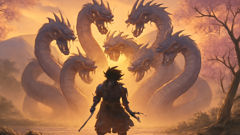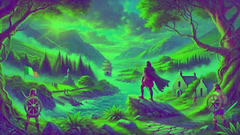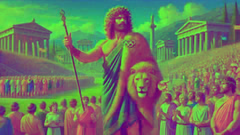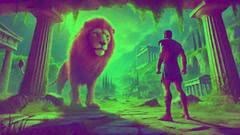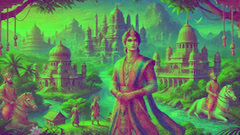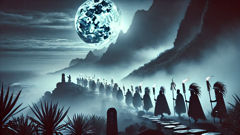Introduction
In the twilight mists of ancient Izumo, where the mountains rise like sleeping giants and the rivers carve their patient lines through emerald forests, a legend was born that would echo through centuries. It is a tale woven into the very fabric of Japan’s cultural memory—a story of gods and monsters, of courage discovered in the face of overwhelming fear, and of destiny grasped by a mortal hand. This is the myth of Susanoo, the tempestuous storm god, and his epic confrontation with the nightmarish Yamata no Orochi, the eight-headed, eight-tailed dragon whose shadow haunted the land. Long before the age of emperors and samurai, before shrines dotted the countryside and cherry blossoms heralded the spring, the world was ruled by spirits both benevolent and wrathful. Susanoo, wild and passionate, was driven from the High Plain of Heaven after a storm of arguments with his divine sister, Amaterasu, the radiant sun goddess. Exiled and tempest-tossed, he descended to the mortal realm, where mountains shimmered with hidden power and ancient trees whispered secrets to the wind. Here, he encountered a land paralyzed by fear—a family in mourning, a princess on the verge of sacrifice, and a monster whose very name conjured terror: Yamata no Orochi. Each year, the dragon demanded a daughter, leaving only the youngest, Kushinada-hime, trembling on the banks of the Hi River. As Susanoo listened to the tale of sorrow and dread, something stirred within him. Perhaps it was pity, or perhaps a spark of heroism that had long lain dormant. He vowed to face the impossible and restore hope to the people of Izumo. What unfolded on that misty riverbank was not just a battle of strength, but a contest of wits, bravery, and fate. The legend of Susanoo and Yamata no Orochi endures because it is more than a story—it is a reminder that even in the darkest valleys, a single act of courage can turn the tide and give birth to legends.
The Exile of Susanoo: Descent to the Mortal Realm
In the celestial halls of Takamagahara, Susanoo’s voice boomed like thunder, his passions as restless as the storms he commanded. His quarrels with Amaterasu, the sun goddess and his elder sister, had grown too fierce to bear. Lightning flashed in his eyes and his footsteps shook the firmament. The heavenly deities watched in mounting dismay as their world was rocked by discord. At last, the gods gathered in solemn council. Their judgment was swift and severe: Susanoo was to be cast down from the heavens, banished until he could learn humility and restraint.

His exile began with a thunderclap. Susanoo plunged from the cloud-wreathed heavens, falling through veils of mist until his feet met the rugged earth of Izumo. The mortal realm was a land of profound beauty and wild power: forests dense with cedar and pine, mountains that seemed to touch the sky, rivers that shimmered with ancient magic. But it was also a world marked by sorrow. As Susanoo wandered, he noticed the silence in villages, the shuttered windows, the anxious glances cast toward the east. He felt the ache of loneliness, a god among mortals, his powers dimmed but not extinguished.
It was on the banks of the Hi River that Susanoo’s destiny revealed itself. He came upon a humble hut, its thatched roof bowed beneath years of grief. Before it sat an old man and woman, their faces etched with sorrow deeper than any wrinkle. Beside them knelt their daughter, Kushinada-hime, her eyes rimmed with tears but burning with quiet dignity. The family’s tale tumbled forth like the river’s current. Each year, they explained, the monstrous Yamata no Orochi emerged from the distant mountains, demanding a daughter as tribute. Seven sisters had already been claimed, their laughter now only a memory carried on the wind. Now only Kushinada-hime remained, and with her, the last fragile hope of a family—and a village—on the brink of despair.
Susanoo’s heart, long calloused by pride and tempestuous rage, was moved by their suffering. For the first time since his exile, he felt the tug of purpose—a calling not born of divine rivalry but of compassion. He knelt before the family, promising protection not as a god seeking worship but as a warrior sworn to shield the innocent. In that promise, a new resolve took root. Susanoo was no longer merely a force of nature; he was a champion, determined to confront the darkness that held Izumo in its merciless grasp.
As twilight descended, Susanoo studied the land. He listened to the whispers of the river and the sighing wind in the trees. He learned from Kushinada’s parents the legend of Orochi: a beast so vast that its body spanned eight valleys and eight hills, its eyes red as coals, its bellies ever hungry for flesh. With each telling, the dragon seemed to grow, until it filled the very landscape with dread. Yet Susanoo was undeterred. Drawing strength from the earth beneath him, he devised a plan—one that would demand both cunning and courage. If he could not match Orochi’s strength head-on, perhaps he could turn the beast’s own nature against it.
Before dawn, Susanoo prepared his weapons and set forth the first pieces of his scheme. He would need sake—enough to fell a giant, let alone a dragon. He would need traps clever and strong, and above all, he would need the trust of those he sought to save. As he worked through the night, forging swords and brewing potent rice wine, the people of Izumo watched in awed silence. In Susanoo, they saw not only a god in exile, but a spark of hope flickering in the encroaching darkness. The stage was set, and the winds of destiny began to stir.
The Cunning Trap: Sake and Sacrifice
As the first rays of dawn painted the Hi River in shades of gold and rose, Susanoo set his plan in motion. He asked Kushinada-hime’s parents for eight barrels of the strongest sake they could brew. Their hands trembled as they worked, pouring their hope into each batch of rice wine. In the hush before battle, Susanoo transformed Kushinada-hime into a delicate comb, tucking her safely into his hair so the dragon could not find her. The gesture was both protective and symbolic—a promise that no harm would come to her while he drew breath.
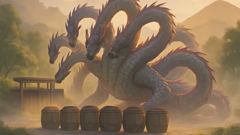
With the villagers’ help, Susanoo erected eight sturdy gates along the riverbank, one for each of Orochi’s heads. Before each gate, he placed a barrel of sake, its aroma so rich it seemed to perfume the entire valley. As preparations neared completion, tension crackled in the air. Birds fell silent; even the river seemed to hold its breath. The villagers retreated to their homes, shuttering doors against what was to come. Only Susanoo remained, a solitary figure standing between life and annihilation.
The ground began to tremble. Leaves fluttered down in shivering cascades. From the eastern horizon, a shadow darker than night slithered into view—the Yamata no Orochi. Its eight heads reared high, each mouth lined with fangs longer than a man’s arm. The dragon’s scales glistened like wet obsidian, its eyes burning with ancient malice. It moved with the slow inevitability of a gathering storm, its enormous body undulating across hills and valleys, flattening everything in its path.
Orochi’s heads sniffed the air, drawn by the scent of sake. One by one, they dipped into the barrels, guzzling the potent wine. The dragon’s roar softened to a gurgle. Its limbs wobbled as the powerful brew coursed through its veins. Susanoo watched from his vantage point, every muscle coiled in anticipation. He knew that strength alone could not defeat such a beast, but intoxication might dull its senses just long enough.
When at last the mighty dragon lay slumped across the gates, drunk and stupefied, Susanoo struck. With a cry that split the dawn, he brandished his sword and charged. The battle that followed was chaos incarnate—a whirlwind of flashing steel, snapping jaws, and spraying blood. Susanoo darted between Orochi’s writhing necks, slashing with precision honed by divine power and mortal desperation. Each severed head fell with a crash that echoed across Izumo. The earth shook with the dragon’s death throes; the river ran red with its lifeblood. Even as exhaustion threatened to overwhelm him, Susanoo fought on, driven by the memory of Kushinada-hime’s tears and the trust placed in him by the villagers.
Finally, with a final roar that shook the mountains, Susanoo severed the last head. Orochi’s monstrous body convulsed and then collapsed, its shadow lifted from the land at last. In the dragon’s tail, Susanoo found something extraordinary—a gleaming sword of divine craftsmanship. He pulled it free, its blade glinting with otherworldly light. This was Kusanagi-no-Tsurugi, the Grass-Cutting Sword, a gift of fate for bravery beyond measure.
The people of Izumo emerged from their homes to witness the aftermath. Where once there had been despair, now there was awe and gratitude. Susanoo returned Kushinada-hime to her true form, and together they stood before a grateful village. The air was thick with relief and celebration. Songs were sung, prayers offered, and the tale of Susanoo’s victory spread like wildfire, carried on every breeze. Through cunning, courage, and compassion, Susanoo had turned tragedy into triumph—and forged a legend that would outlive even the gods.
Victory, Redemption, and the Birth of a Legend
The land of Izumo exhaled as if waking from a nightmare. The curse of Yamata no Orochi was broken; sunlight streamed unobstructed onto fields and forests for the first time in years. Yet for Susanoo, the victory was more than a triumph over a monstrous foe—it was the moment his fate entwined with both mortal and divine legacies.
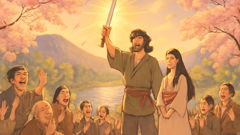
As celebrations erupted in the village, Susanoo felt the weight of his journey settle upon him. He had arrived in Izumo a disgraced god, shunned by his kin, burdened by pride and anger. Yet here he stood, not as an outcast, but as a hero embraced by those he had saved. Kushinada-hime’s family, weeping with joy, offered their daughter’s hand in gratitude and respect. Susanoo accepted with humility, recognizing in her eyes the courage that had matched his own. Their union was not only a reward for bravery but a promise to protect Izumo for generations to come.
The sword Kusanagi-no-Tsurugi, gleaming with divine light, was presented by Susanoo to Amaterasu as a gesture of reconciliation and respect. It would become one of the Three Imperial Regalia of Japan—a symbol of unity between heaven and earth, of balance between strength and wisdom. The tale of how it was won would be told for centuries in poem and song, painted on screens and whispered beneath cherry blossoms. Susanoo’s own heart was changed by his ordeal. In protecting the innocent and confronting evil with both cunning and compassion, he discovered virtues greater than any tempest he had ever conjured. The storm god found peace in the arms of those he had saved, and in doing so, redeemed himself in the eyes of gods and mortals alike.
Kushinada-hime, too, emerged from the shadow of sacrifice transformed. Her faith in Susanoo’s promise became a beacon for her people, a reminder that hope could flourish even when all seemed lost. Together, she and Susanoo rebuilt what had been destroyed—fields were replanted, homes repaired, and laughter returned to village squares. The Hi River, once tainted by sorrow, flowed clear again. Every spring, cherry trees blossomed along its banks in honor of Kushinada-hime, their petals floating on the breeze like blessings from the gods.
With time, Susanoo became a revered deity in Izumo, worshipped not just as a storm god but as a protector and peacemaker. Shrines were erected in his honor; festivals celebrated his victory over Orochi with dances, music, and offerings of sake. The people never forgot the lesson of the dragon’s defeat—that even in times of terror, courage and cleverness could prevail. And as dawn broke over Izumo each day, it seemed to carry a silent promise: that so long as hope endures, no darkness is truly unconquerable.
Conclusion
The myth of Susanoo and Yamata no Orochi endures not simply for its spectacle of gods and monsters, but for the timeless truths it carries. In Susanoo, we find a flawed hero whose greatest strength emerges not from divine birth but from empathy, cleverness, and the willingness to face fear head-on. His journey from exile to redemption mirrors the struggles within every human heart—the longing for belonging, the hope for forgiveness, and the courage to fight for what matters most. In Kushinada-hime’s quiet bravery and the resilience of Izumo’s people, we see the enduring power of hope and unity. The slaying of Yamata no Orochi is more than a victory over evil; it is a testament to the spirit that binds communities and generations, inspiring songs, prayers, and legends throughout Japanese history. And from the bloodied tail of a defeated dragon rose Kusanagi-no-Tsurugi, a symbol of harmony between heaven and earth—a legacy passed from gods to mortals, echoing through time as a promise that even in darkness, light may prevail. So the tale is told and retold: not just as a memory of ancient battles, but as a call to courage for all who listen.

